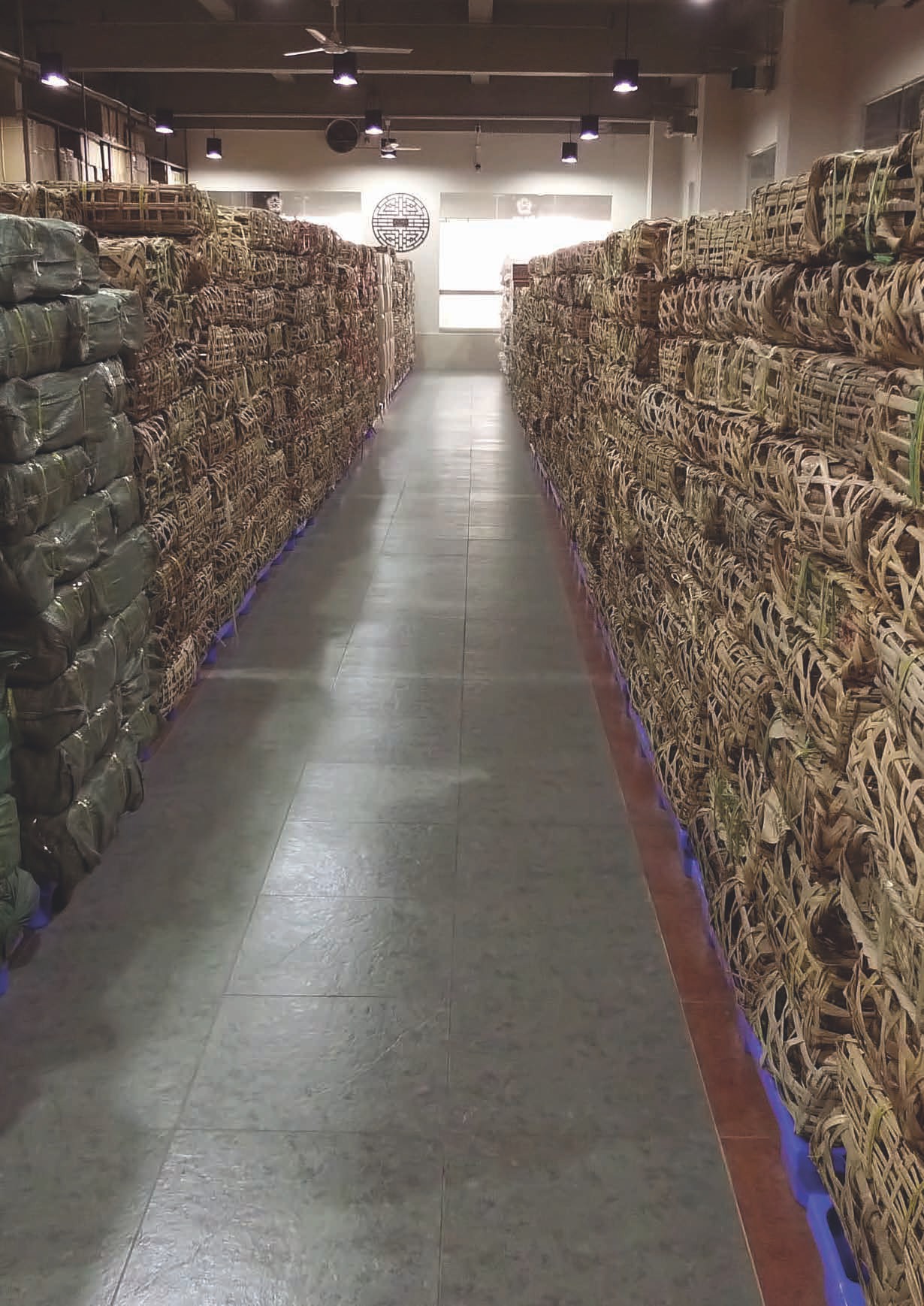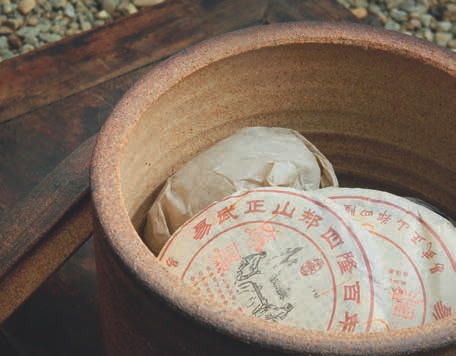
 |
|
The puerh tea that came to Taiwan from Hong Kong in the early days often had what was referred to as a "stinky" aroma - this was indicative of less than ideal storage conditions, which led to the tea being contaminated by other scents. This misled many early consumers into believing that puerh tea was supposed to smell this way. It wasn't until the last few years, when Taiwan began promoting dry storage for aging puerh, that opinions began to change. In the early days in Hong Kong, nearly all puerh tea would undergo a period of wet storage in a basement or other humid place, to speed up fermentation and give the tea liquor an aged flavor. Nowadays, it is better to call such tea "Hong Kong" or "Traditional" storage.
But these storage methods also changed the style of puerh tea and made it lose some of its original character; in addition, the proportion of tea leaves that were damaged or spoiled during the storage process was around 30%. This would represent a very big loss, so those damaged leaves were included in the tea that was sold, to bring in more value.
Of course, tea merchants and consumers didn't know this, so they were deceived. Even now, in this age of information transparency, it's taken people a long time to cast off this fog of misperception and realize that this flavor was a product of the specific humid storage conditions in Hong Kong, and not a characteristic of puerh itself. So, here in Taiwan, I have put a lot of effort into recommending puerh that has been aged in dry storage. Although puerh is post-fermented, it still retains the character of the original tea; the more appropriate the storage, the more appealing the end product.
In the early days, there wasn't a lot of acceptance of dry-aged puerh in Taiwan. Then, as now, if one hadn't ever come across dry-stored puerh, there was no opportunity to experience the true grace and charm of puerh tea. Consumers were generally used to drinking quite soft, mellow teas, and dry-aged puerh is unable to reach that level of mellowness in less than ten years; it starts out quite sharp, and only after twenty years or more does it begin to mellow slightly. So really, it takes around twenty years to produce a tea that most people will find easily palatable. From a business perspective, storing tea for twenty years before being able to sell it isn't very feasible, yet it had to be done in Taiwan. So, in the beginning, it was very difficult to promote dry storage in Taiwan. Tea merchants had to suffer the torments of time; and time was also necessary to prove the success of the method. After the ten years had passed, the puerh tea aged in Taiwan would begin to display different characteristics, thanks to these different storage techniques.

In the early days in Taiwan, there wasn't a particular principle behind puerh storage; it was simply about finding a place to stack all the puerh that had been bought from Hong Kong. As the volume of imports increased, there was no longer enough space for all the tea, and the value of tea leaves was also on the rise. It was only at this point that the tea merchants began to realize the importance of dedicated storehouses. So, the need for tea warehouses grew out of the need to run a sustainable tea business. When establishing the first storehouses, tea merchants really had to have long-term vision. They also had perseverance. Without dedicating themselves fully to the occupation of selling tea, it would be very difficult for the business to last. The construction and layout of the tea storehouses came about through a process of trial and error. The Taiwanese methods were based on the experience of Hong Kong merchants, then improved upon. In Hong Kong, the tea was generally stacked into piles; this was a good way of saving space, even with large volumes of tea, and also aided the post-fermentation of the tea leaves.
In early storehouses in Taiwan, the tea was stored on iron angle shelving to be able to stack it and aid the post-fermentation process. Many different merchants used this method. However, a year later, these iron shelves were eliminated, as tea merchants continued to ponder more efficient storage methods.
So, with the combined goal of aiding fermentation and increasing space efficiency, the experimentation led to the adoption of the storage method that's still used now: steel angle shelving. Each shelf can take quite a lot of weight, so through a lot of calculations, today's tea merchants are able to achieve very efficient warehouse management, in terms of both keeping track of inventory and classifying goods.
The problems faced by early warehouse operators, such as excess humidity or insect damage, have all been addressed by modern storage methods. During this early period of experimentation, new methods were developed by trial and error; when a new problem arose, they found a new solution. Of course, I'm only able to describe the innovations that have happened up until now - who knows what superior methods may be developed in the future?

A modern tea warehouse must account for the necessary hardware, plus the need to protect the tea leaves from excess humidity and unintended odors. When the tea is stacked to a certain level and the warehouse temperature is higher than the outdoor temperature, the tea leaves will tend to absorb all available moisture, and can easily become moldy if it's too humid. The storage facilities must be kept dry and well-ventilated. During the damp "plum rain" season, more dehumidifiers must be added; while in the summer when it gets too hot, fans are needed to increase air flow. To avoid insect damage, mosquito lamps are used, and the whole facility must be carefully monitored to make sure no water leaks in from outside. If there's ever a problem with any of these, it must be fixed as quickly as possible.
The tea merchants also noticed that post-fermentation could produce different results in teas that were stored in different places. As soon as a puerh cake is produced, it begins to oxidize, and this process of fermentation continues indefinitely, at all times, unless it is artificially stopped by sealing up the tea. In Taiwan, there are no artificial methods used to increase the degree of fermentation of the tea - the methods used to achieve the ideal post-fermentation are all natural.
Once you have stored all your tea leaves in one place, it's important to check that the only scents in the warehouse are the fragrances of the tea - the tea leaves must not be exposed to any other odors. In Taiwan, a basement is a good choice of location to store tea, as it stays warm in the winter and cool in the summer.
The main thing to be careful of with basements is the humidity. To combat this, we installed an extractor fan in the basement and made sure the entrance has plenty of ventilation, to ensure sustained air flow. A few years into this experiment, we found that it was beneficial to the development of the tea. When adding new teas to the basement, they're also liable to be susceptible to humidity, so it's important to monitor this regularly, checking on the tea every few months.
If a tea is unsuited to being stored in the basement, then you'll need to move it upstairs. The temperature on the top story is comparatively high, so the tea will change more rapidly. To really understand tea storage, two factors are essential: time and practical firsthand experience.
Once the storage facilities are all properly set up, the only thing left to add is the care and dedication of the people who look after the tea. Taiwan's tea warehouses are very clean and pleasant. Each layer in the stacks of tea is the height of two cylinder-shaped tea packages. Every half a year, the loose-leaf tea must be turned over, as loose-leaf is the least well-ventilated while fermenting, so every single bag of tea must be flipped. Puerh cakes, by comparison, are moved once a year. Thanks to this, there has been no sign of mold in Taiwan's tea warehouses. In dry storage warehouses, one can determine the tea's current stage in the aging process by analyzing its scent. The further along it is, the richer and more fragrant the aroma; and when a lot of tea is stored in one place, the whole warehouse becomes like a giant air conditioner, which is beneficial for the fermentation of the tea.
Only when the outside conditions are particulary unfavorable (such as in the plum rain season) does special caution become necessary. And the cleaner the warehouse is kept, the less chance there is of the tea leaves absorbing unwanted odors. When new and old teas are stored together, this will benefit the oxidization of the new tea. So, all the teas from Taiwan's storehouses have a special sort of fragrance: the scent of a Chajin's care and dedication.
Nowadays, many Chajin are wholeheartedly committed to professionalism and to further developing and promoting puerh tea. This is a way of preserving traditional Chinese culture and honoring the efforts of our forebears; if those who came before us hadn't produced such excellent puerh, how would we of future generations have the opportunity to taste such wonderful aged tea?
The aroma of tea is not just the fragrance of the leaves themselves; it also contains the traces of the toil and dedication of those who came before us. Today, living in such prosperous times, we have all the more opportunity to create a bright future for tea, so that the Chajin of the future may also have the chance to drink a wonderful cup of puerh and feel the heart and dedication of their forebears. This is a beautiful inheritance; may we all work together to pass it on!


This is a large warehouse in Guangzhou, where several thousand tons of puerh tea are aged professionally.